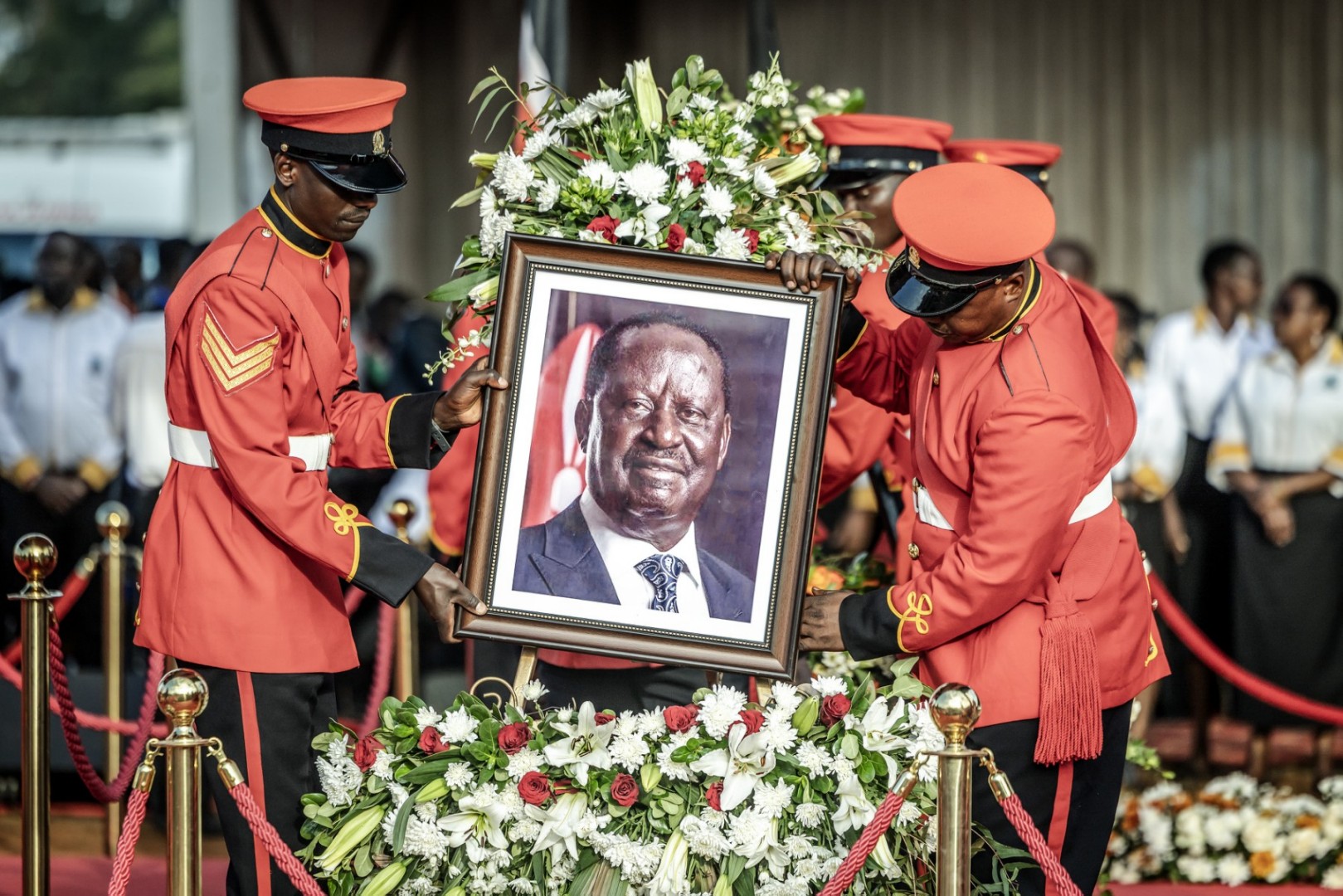
False claims surround death of former Kenyan prime minister Odinga
- Published on October 24, 2025 at 11:46
- 6 min read
- By Peris GACHAHI, AFP Kenya
Kenya’s former prime minister Raila Odinga died on October 15, 2025, reportedly from cardiac arrest while undergoing treatment in India. The veteran opposition leader’s death was followed by a surge of misinformation online, with social media users sharing clips and images purportedly showing his final moments and the aftermath. However, these posts are false; some misidentify people and locations, while others feature content generated using artificial intelligence tools.
Odinga, fondly known as “Baba” (father) to his supporters, died in Kerala, India, at age 80 (archived here).
The Orange Democratic Movement (ODM) party leader’s body was repatriated to Kenya, where tens of thousands gathered at the airport (archived here).
President William Ruto declared a seven-day national mourning period, and Odinga’s body lay in state at the Kenyan parliament, followed by other public viewings in Nairobi and Kisumu (archived here). At least five people died and dozens were injured in crowd surges during the mourning events (archived here and here).
Odinga was buried on October 19 at his family homestead in Bondo, western Kenya, following a state funeral service in Nairobi attended by African dignitaries and conducted with full military honours (archived here and here).
Born to Kenya’s first vice president, Jaramogi Oginga Odinga, and a member of the Luo tribe, his early political career was either spent in detention or exile for opposing President Daniel arap Moi’s one-party rule, making him a key figure in the movement that ushered in multiparty politics in the 1990s (archived here).
A five-time presidential contender, Odinga later served as prime minister between 2008–2013 in a power-sharing government after the disputed 2007 election turned violent, resulting in more than 1,100 deaths.
Following Odinga’s death, false claims quickly began circulating online.
Animated old image
One of the clips was published on Facebook a few hours after the announcement of Odinga’s death.
In the clip, Odinga can be seen lying on a bed as hospital staff cover him with a white sheet.
“End of an Era: Witnessing Raila Odinga's Last Moments,” the text overlaid on the clip reads.

The video was also shared on TikTok with similar claims.
AFP conducted reverse image searches on keyframes from the clip and found a matching photo from 2017.
The photo was published by local news outlet Nation on July 9, 2017, on X in a post reading: “NASA LEADER Raila Odinga admitted at Mombasa Hospital after addressing rallies in Kilifi County, spokesperson Onyango says” (archived here).
Odinga was discharged from the hospital the following day. He explained that he was just dehydrated (archived here).

Several clues suggest that this photo was transformed into a video using AI tools.
The first frame is an exact match of the original photo, which is consistent with how photo-to-video AI tools operate -- starting with a still image and generating motion from it.
The medical attendant’s visibly deformed fingers and the sudden appearance of a pocket on his T-shirt two seconds into the clip are also clear indicators of AI-generated manipulation.

Misidentified mourner
On the same day, another clip was published on X, purporting to show Odinga’s widow, Ida Odinga, mourning at their rural home in Bondo, Siaya county.
“Bondo! Dr. Ida Odinga mourning her husband! Rest In Peace Baba Raila Odinga,” the post reads.
In the clip, a woman in a red dress is seen wailing loudly as some mourners record her on their phones, while others soon join in her weeping.

Contrary to the claim, Odinga’s widow was at their Karen home in Nairobi the morning of his death (archived here). She arrived at their Bondo residence on October 18, 2025, and we found no footage of her from a credible source publicly wailing.
AFP Fact Check conducted reverse image searches on keyframes from the clip and found other posts indicating it shows locals mourning at Odinga’s Bondo home following the news of his death.
A different angle shared on TikTok confirms that the woman in the clip is indeed not Odinga’s widow.

Haiti protests
On October 18, 2025, as Odinga’s remains were taken to Kisumu for public viewing at the Jomo Kenyatta stadium in Mamboleo and later to his Bondo home, another clip purportedly showing mourners flooding the streets of the western Kenya city surfaced online.
“Kisumu is Ready to Baba Raila Odinga (sic),” reads an Instagram post that shared the clip.
It shows a crowd chanting while advancing along a street.

We conducted reverse image searches on keyframes from the clip and found that the footage is old and unrelated to Odinga’s death.
An identical clip was published by French broadcaster France 24 on June 10, 2019, with the headline: “Protests in Haiti: more than President Moïse's resignation, but a future for the country” (archived here).
The clip appears at the 1’31” mark when the same chants can be heard.
Visual clues, like shop fronts and signs, confirm that the footage was captured at the same location.

The clip was also published by the Associated Press on YouTube at the time, with the title: “Haiti: Thousands protest corruption; two dead” (archived here).
AI-generated images
On the eve of Odinga’s remains being transported to Kisumu, his supporters held night vigils in the city (archived here).
An image purportedly showing a large crowd of mourners during one such vigil, featuring a large banner in Swahili reading, “Baba we love you,” was circulated online.
“Thank You Kisumu. BABA IS HAPPY,” a post published on X reads.
Other social media users shared the same image, claiming it showed mourners in Nairobi.
“There will be no other Baba. This is Nairobi farewell for the Enigma this late at night (sic),” reads one such post on Facebook.

Another Facebook post claimed to show an aerial view of a packed Jomo Kenyatta Stadium in Kisumu during the public viewing of Odinga’s remains.
“RIP BABA. Kisumu Mamboleo Stadium,” it reads.

AFP Fact Check conducted reverse image searches and found that both the vigil and stadium images were published on a TikTok account with the username “normantv254”.
The account predominantly publishes AI-generated visuals and has different variations of these images, all labelled as AI-generated by the creator.

We did not find the image of the vigil with the “Baba we love you” banner or its variations published by any credible source.
Notably, the real Jomo Kenyatta stadium is structurally different from the one shared on Facebook.
While large crowds were indeed reported at the Kisumu public viewing, aerial footage published by local media outlet NTV shows clear differences in the facility’s shape, roofing, and number of entry and exit points (archived here).

Copyright © AFP 2017-2025. Any commercial use of this content requires a subscription. Click here to find out more.
Is there content that you would like AFP to fact-check? Get in touch.
Contact us




